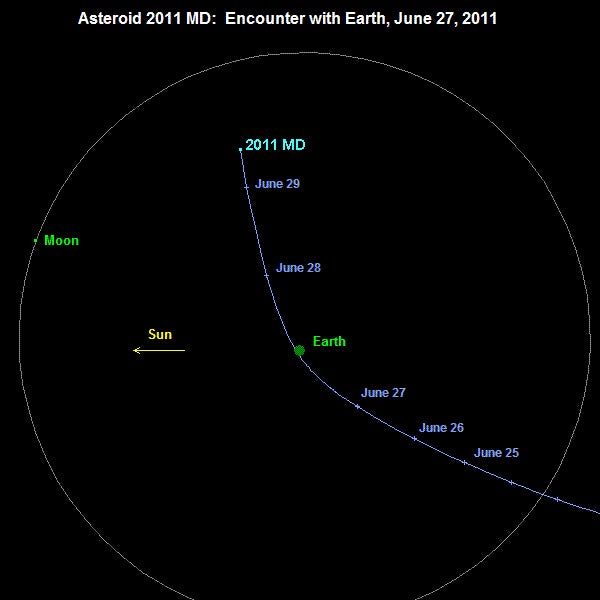The top diagram shows the trajectory of 2011 MD projected onto Earth’s orbital plane over a 4-day interval. The diagram below it gives another view from the general direction of the Sun that indicates that 2011 MD will reach its closest Earth approach point in extreme southern latitudes (in fact, over the southern Atlantic Ocean).
This small asteroid, only between 15 and 65 feet (5 and 20 meters) in diameter, is in a very earthlike orbit about the Sun, but an orbital analysis indicates there is no chance it will actually strike Earth on Monday. The incoming trajectory leg passes several thousand kilometers outside the geosynchronous ring of satellites and the outgoing leg passes well inside the ring. One would expect an object of this size to come this close to Earth about every 6 years on average. For a brief time, it will be bright enough to be seen even with a modest-sized telescope.
For more observing information for asteroid 2011 MD, visit the Inernational Astronomical Union’s Minor Planet Center website.
The top diagram shows the trajectory of 2011 MD projected onto Earth’s orbital plane over a 4-day interval. The diagram below it gives another view from the general direction of the Sun that indicates that 2011 MD will reach its closest Earth approach point in extreme southern latitudes (in fact, over the southern Atlantic Ocean).
This small asteroid, only between 15 and 65 feet (5 and 20 meters) in diameter, is in a very earthlike orbit about the Sun, but an orbital analysis indicates there is no chance it will actually strike Earth on Monday. The incoming trajectory leg passes several thousand kilometers outside the geosynchronous ring of satellites and the outgoing leg passes well inside the ring. One would expect an object of this size to come this close to Earth about every 6 years on average. For a brief time, it will be bright enough to be seen even with a modest-sized telescope.
For more observing information for asteroid 2011 MD, visit the Inernational Astronomical Union’s Minor Planet Center website.











